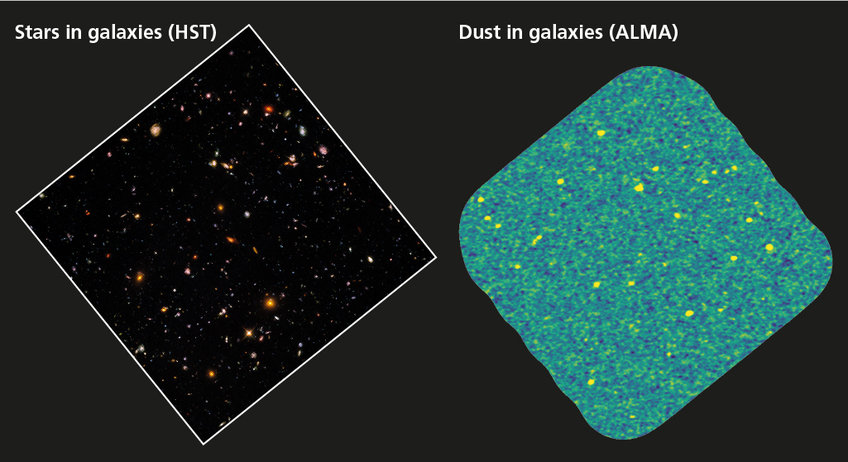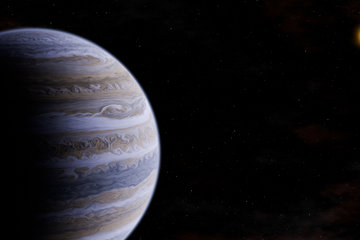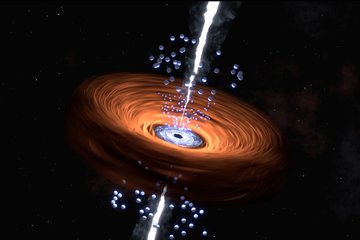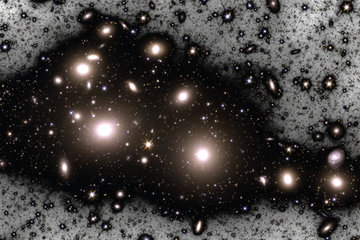A glance into the cosmic star factory
Astronomers observe how the fuel for star formation has evolved over the course of the history of the universe

Deep insights: The Hubble Ultra-Deep Field (UDF, left) is one of the most intensively studied regions of the sky. Using the Hubble Space Telescope, astronomers have identified hundreds of galaxies in the UDF. The light from the most distant of these galaxies has taken more than 13 billion years to reach us. On the right, the same region observed during the ASPECS survey. The image reveals radiation from dust clouds in the UDF galaxies, as they appear at wavelengths in the millimetre range. This ALMA image provides the deepest view to date of the distant dusty universe.
Over the course of many billions of years, a huge number of stars have formed in galaxies. The building material from which stars are created is cool gas composed of hydrogen molecules. To ensure that this is available in sufficient quantities, the hydrogen reservoir needs to be constantly replenished. Such an enormous reservoir does indeed exist in the vast spaces between the galaxies in the form of warm intergalactic plasma, which makes up more than 90 percent of all hydrogen in the universe. By determining how this reservoir changes over time, astronomers can better understand the history of stellar production rates in galaxies.
Telescopes are, in a manner of speaking, time machines, since due to the finite speed of light, gazing into the far distance is like travelling into the past. If, for example, astronomers want to discover the average properties of the universe a billion years ago, they need just observe objects that are so distant that it took a billion years for their light to reach us.
If the process is repeated for different distances corresponding to different cosmic epochs, astronomers can obtain a “drill core” that provides an average history of the universe. The details will vary, but the big picture of cosmic evolution obtained in this way should provide an overview of the evolution of the universe as a whole.
The study by Fabian Walter’s team at the Max Planck Institute for Astronomy in Heidelberg, Germany, utilized the Hubble Ultra-Deep Field (UDF) to obtain a particularly important drill core. Between 2003 and 2004, the Hubble Space Telescope captured hundreds of images of this small region of the sky, only a tenth of the apparent diameter of the full moon, with a total exposure time of almost 16 days.
The Ultra-Deep Field reveals galaxies whose light has travelled some 13 billion years to reach us. Previous studies had painted a consistent picture of star formation history: star production apparently ramped up after the Big Bang to a veritable boom some ten billion years ago, followed by a continuous decline in production rates. Approximately half the stars in the universe had already been produced by the time the universe was 4.5 billion years old, a third of its current age. Afterwards, the stellar baby boom waned. But why the increase and subsequent decline?
To answer this question, Fabian Walter and his colleagues investigated how much raw material in the form of molecular hydrogen was available for star formation at different ages of the universe. The astronomers used the ALMA observatory in Chile, which can combine up to 50 large (sub)millimetre telescopes by means of interferometry. This technique combines individual telescopes to dramatically increase the sensivity and resolution.

In 3-D: ASPECS observations can provide us with a three-dimensional view of distant galaxies in the Hubble Ultra-Deep Field (UDF). The third dimension, namely the distance from the observer, can be deduced from the cosmological redshift. ALMA utilizes the spectral lines of carbon monoxide to observe molecular gas. For distant galaxies, these lines are shifted to lower frequencies due to the expansion of the universe. ALMA can be used to determine the frequencies of the observed radiation. Thanks to cosmic expansion, this third dimension of the observations, the frequency, reflects the distance of the radiation source to us, resulting ultimately in a three-dimensional map. The figure depicts the data gathered by ALMA, in which the “islands” in volume correspond to the molecular gas emission lines of distant galaxies.
During the ALMA Spectroscopic Survey in the Hubble Ultra-Deep Field (ASPECS), astronomers obtained two spectra for each location in the Hubble Field, recording the intensity of the captured light at wavelengths between 1.1 and 1.4 millimetres and between 2.6 and 3.6 millimetres. These spectra reveal the presence of molecules via “emission lines”. Their intensity indirectly reflects how much molecular hydrogen is present in the region concerned.
By taking into account the redshift observed for a particular set of lines, it is possible to reconstruct the distance of the gas in question. In an expanding universe, this cosmological redshift is directly related to an object’s distance from us. In this way, ASPECS was able to map the distribution of gas-clouds in three dimensions.
In this way, Fabian Walter’s team was able to reconstruct the evolution of molecular hydrogen reservoirs in galaxies over almost the entire history of the universe – from about two billion years after the Big Bang 13.8 billion years ago to the present. The scientists also drew together existing data on atomic hydrogen and on the total mass of all stars in a given epoch. In addition, they compared their findings with large-scale simulations of cosmic history from the Big Bang to the present.
The researchers discovered that over the course of cosmic history, the amount of molecular hydrogen increased until about ten billion years ago, with the inventory almost doubling within three billion years. After this rise, there is a steady decline of the molecular gas reservoir with time. This evolution had already been suggested by previous studies. But only now are the observations sufficiently accurate to safely conclude how cosmic gas density rises and falls over time.
The initial rise, therefore, represents a “golden age” of star formation, with plenty of raw material just waiting to be turned into blazing suns and with half of the stars that ever existed being created in that first third of cosmic history. At the high point, there was about as much molecular hydrogen as atomic hydrogen present in galaxies.
Comparing their data with simulations, the astronomers found that the boom in molecular hydrogen was due to several factors. Galaxies are only the visible “tip of the iceberg” of accumulations of dark matter – matter that does not interact with electromagnetic radiation and, thus, cannot be observed directly. Dark matter accounts for about 80 percent of the total mass in the universe and plays an important role in the birth of galaxies.
This is because shortly after the Big Bang, dark matter was initially distributed almost perfectly homogeneously throughout the cosmos. Since that time, however, it has increasingly clumped together, owing to mutual gravitational attraction. In the present-day universe, on a scale of hundreds of millions of light-years, dark matter forms a network of filaments, sprinkled with particularly dense regions known as halos.
Galaxies formed when ordinary matter, mostly hydrogen gas, was drawn into those halos by the gravitational attraction of their dark matter. In this process, first the plasma falls onto halos from the huge reservoir in intergalactic space, cooling down to form atoms. This replenishes the supply of atomic hydrogen within galaxies.
A portion of the atomic hydrogen flows to the galactic center, where it continues to cool down and forms molecular hydrogen, and eventually stars. The ASPECS observations allowed Fabian Walter and his colleagues to describe how powerful these gas flows were in the different phases of cosmic history.
Looking into the future, as halo growth slows down and less hydrogen plasma is drawn onto galaxies, star production will become less effective over time. At present, galaxies form stars at only a tenth of the production rate of the golden age.
Overall, production rates have been in sharp decline for the past nine billion years. Based on their observations, Walter’s group predicts a continuing trend: over the next five billion years, the molecular gas reservoirs will shrink to half their present mass, while the total mass of stars in the universe will increase by only ten percent. Eventually, stellar production will cease altogether.
In a next step, astronomers intend to use ALMA to take a closer look at individual galaxies and, in particular, compare the structure of the molecular gas and dust they contain with the distribution of their stars. This will provide answers to several questions. For example, are the two directly related? And is molecular gas and dust found in the same region as the young stars? More detailed observations would also yield information on the kinematics, temperature, and density of the gas.
MP / HOR













